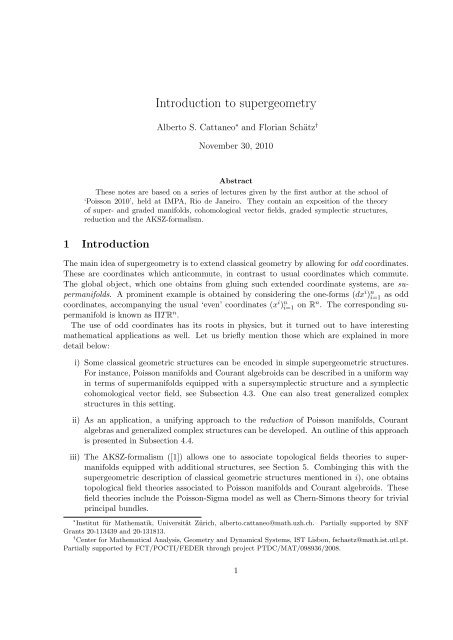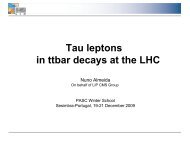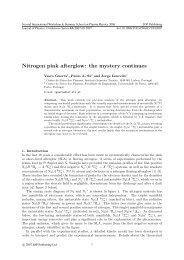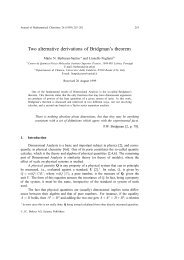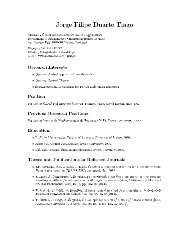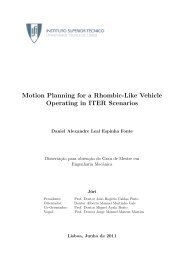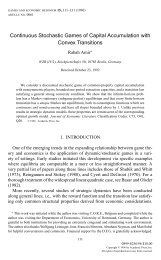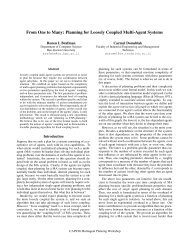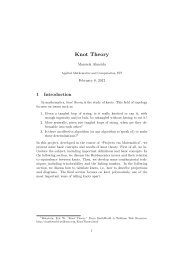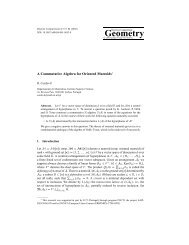Introduction to supergeometry
Introduction to supergeometry
Introduction to supergeometry
You also want an ePaper? Increase the reach of your titles
YUMPU automatically turns print PDFs into web optimized ePapers that Google loves.
<strong>Introduction</strong> <strong>to</strong> <strong>supergeometry</strong><br />
Alber<strong>to</strong> S. Cattaneo ∗ and Florian Schätz †<br />
November 30, 2010<br />
Abstract<br />
These notes are based on a series of lectures given by the first author at the school of<br />
‘Poisson 2010’, held at IMPA, Rio de Janeiro. They contain an exposition of the theory<br />
of super- and graded manifolds, cohomological vec<strong>to</strong>r fields, graded symplectic structures,<br />
reduction and the AKSZ-formalism.<br />
1 <strong>Introduction</strong><br />
The main idea of <strong>supergeometry</strong> is <strong>to</strong> extend classical geometry by allowing for odd coordinates.<br />
These are coordinates which anticommute, in contrast <strong>to</strong> usual coordinates which commute.<br />
The global object, which one obtains from gluing such extended coordinate systems, are supermanifolds.<br />
A prominent example is obtained by considering the one-forms (dx i ) n i=1 as odd<br />
coordinates, accompanying the usual ‘even’ coordinates (x i ) n i=1 on Rn . The corresponding supermanifold<br />
is known as ΠT R n .<br />
The use of odd coordinates has its roots in physics, but it turned out <strong>to</strong> have interesting<br />
mathematical applications as well. Let us briefly mention those which are explained in more<br />
detail below:<br />
i) Some classical geometric structures can be encoded in simple supergeometric structures.<br />
For instance, Poisson manifolds and Courant algebroids can be described in a uniform way<br />
in terms of supermanifolds equipped with a supersymplectic structure and a symplectic<br />
cohomological vec<strong>to</strong>r field, see Subsection 4.3. One can also treat generalized complex<br />
structures in this setting.<br />
ii) As an application, a unifying approach <strong>to</strong> the reduction of Poisson manifolds, Courant<br />
algebras and generalized complex structures can be developed. An outline of this approach<br />
is presented in Subsection 4.4.<br />
iii) The AKSZ-formalism ([1]) allows one <strong>to</strong> associate <strong>to</strong>pological fields theories <strong>to</strong> supermanifolds<br />
equipped with additional structures, see Section 5. Combinging this with the<br />
supergeometric description of classical geometric structures mentioned in i), one obtains<br />
<strong>to</strong>pological field theories associated <strong>to</strong> Poisson manifolds and Courant algebroids. These<br />
field theories include the Poisson-Sigma model as well as Chern-Simons theory for trivial<br />
principal bundles.<br />
∗ Institut für Mathematik, Universität Zürich, alber<strong>to</strong>.cattaneo@math.uzh.ch. Partially supported by SNF<br />
Grants 20-113439 and 20-131813.<br />
† Center for Mathematical Analysis, Geometry and Dynamical Systems, IST Lisbon, fschaetz@math.ist.utl.pt.<br />
Partially supported by FCT/POCTI/FEDER through project PTDC/MAT/098936/2008.<br />
1
Plan of the notes<br />
Section 2 is a short review of the basics of <strong>supergeometry</strong>.<br />
In Section 3, graded manifolds, as well as graded and cohomological vec<strong>to</strong>r fields, are introduced.<br />
The concept of cohomological vec<strong>to</strong>r fields allows one <strong>to</strong> think of ‘symmetries’, which<br />
appear in a wide variety of examples, in a unified and geometric way. For instance, L ∞ -algebras<br />
and Lie algebroid structures can be seen as special instances of cohomological vec<strong>to</strong>r fields.<br />
In Section 4, graded symplectic manifolds are explained. Due <strong>to</strong> the additional grading, graded<br />
symplectic geometry often behaves much more rigidly than its ungraded counterpart. A dg symplectic<br />
manifold is a graded symplectic manifold with a compatible cohomological vec<strong>to</strong>r field.<br />
Poisson manifolds, Courant algebroids and generalized complex structures fit naturally in<strong>to</strong> the<br />
framework of dg symplectic manifolds. This is explained in Subsection 4.3, while Subsection 4.4<br />
outlines a unified approach <strong>to</strong> the reduction of these structures via graded symplectic geometry.<br />
Finally, Section 5 provides an introduction <strong>to</strong> the AKSZ-formalism ([1]). This is a procedure<br />
which allows one <strong>to</strong> associate <strong>to</strong>pological field theories <strong>to</strong> dg symplectic manifolds. As particular<br />
examples, one recovers the Poisson Sigma model and Chern-Simons theory (for trivial principal<br />
bundles). In this Section, we basically follow the expositions of the AKSZ-formalism from [17]<br />
and [8], respectively.<br />
Acknowledgements. We thank Dmitry Royenberg, Pavol Ševera and Marco Zambon for helpful<br />
comments. Moreover, we thank the school of ‘Poisson 2010’ for partial financial support.<br />
2 Supermanifolds<br />
2.1 Definition<br />
A supermanifold M is a locally ringed space (M, O M ) which is locally isomorphic <strong>to</strong><br />
(U, C ∞ (U) ⊗ ∧W ∗ ),<br />
where U is an open subset of R n and W is some finite-dimensional real vec<strong>to</strong>r space.<br />
isomorphism mentioned above is in the category of Z 2 -graded algebras, i.e. the parity<br />
⊕<br />
C ∞ (U) ⊗ ∧ k W ∗ → Z 2 , f ⊗ x ↦→ |f ⊗ x| := |x| = k mod 2<br />
k≥0<br />
has <strong>to</strong> be preserved.<br />
Loosly speaking, every supermanifold is glued from pieces that look like open subsets of R n ,<br />
<strong>to</strong>gether with some odd coordinates, which correspond <strong>to</strong> a basis of W ∗ . The supermanifold<br />
corresponding <strong>to</strong> such a local piece is denoted by U × ΠW , and we write<br />
C ∞ (U × ΠW ) := C ∞ (U) ⊗ ∧W ∗ .<br />
Similarly, the algebra of polynomial functions on V × ΠW , for V and W real, finite dimensional<br />
vec<strong>to</strong>r spaces, is S(V ∗ ) ⊗ ∧W ∗ . Here S(V ∗ ) denotes the symmetric algebra of the vec<strong>to</strong>r space<br />
V ∗ .<br />
In the global situation, the algebra of smooth function C ∞ (M) on a supermanifold M is<br />
defined <strong>to</strong> be the algebra of global sections of the sheaf associated <strong>to</strong> M. The parity extends <strong>to</strong><br />
C ∞ (M) and C ∞ (M) is a graded commutative algebra with respect <strong>to</strong> this parity, i.e. for f and<br />
g homogeneous elements of degree |f| and |g| respectively, one has<br />
f · g = (−1) |f||g| g · f.<br />
The<br />
2
Examples 2.1.<br />
1. The algebra of differential forms Ω(M) on a manifold M is locally isomorphic <strong>to</strong><br />
C ∞ (U) ⊗ ∧T ∗ x M<br />
where x is some point on U. Hence the sheaf of differential forms on a manifold corresponds<br />
<strong>to</strong> a supermanifold.<br />
2. Let g be a real, finite dimensional Lie algebra. The cochains of the Chevalley-Eilenberg<br />
complex of g are the elements of ∧g ∗ , which is the same as the algebra of smooth functions<br />
on the supermanifold Πg.<br />
2.2 Morphisms of supermanifolds<br />
Since supermanifolds are defined as certain locally ringed spaces, it is natural <strong>to</strong> define morphisms<br />
of supermanifolds as morphims of these locally ringed spaces. In the smooth setting,<br />
one can equivalently define morphisms from M <strong>to</strong> N <strong>to</strong> be morphisms of superalgebras from<br />
C ∞ (N ) <strong>to</strong> C ∞ (M), see [24] or [7].<br />
Let us spell this out in more detail for the local case, i.e. consider a patch of N isomorphic<br />
<strong>to</strong> Ṽ × Π ˜W . In this situation one has<br />
Mor(M, N ) ∼ = Mor alg (C ∞ (N ), C ∞ (M)) ∼ =<br />
(<br />
(Ṽ ⊕ Π ˜W<br />
)<br />
) ⊗ C ∞ (M) .<br />
even<br />
Here, the last object is a super vec<strong>to</strong>r space, i.e. a vec<strong>to</strong>r space with a decomposition in<strong>to</strong> an<br />
even and an odd part. C ∞ (M) is graded by the parity, Ṽ ⊕ Π ˜W is considered with its obvious<br />
decomposition and the parity of a tensor product a ⊗ b is the product of the parities of a and b,<br />
respectively.<br />
The last isomorphism uses the fact that it suffices <strong>to</strong> know the restriction of a morphism<br />
C ∞ (Ṽ × Π ˜W ) → C ∞ (M)<br />
<strong>to</strong> the subspace of linear functions, in order <strong>to</strong> be able <strong>to</strong> recover the morphism itself.<br />
3 Graded manifolds<br />
3.1 Definition<br />
Let us first introduce the relevant linear theory: A graded vec<strong>to</strong>r space V is a collection of vec<strong>to</strong>r<br />
spaces (V i ) i∈Z . The algebra of polynomial functions on V is the graded symmetric algebra S(V ∗ )<br />
over V ∗ . In more detail:<br />
• The dual V ∗ of a graded vec<strong>to</strong>r space V is the graded vec<strong>to</strong>r space (V ∗ −i ) i∈Z.<br />
• The graded symmetric algebra S(W ) over a graded vec<strong>to</strong>r space W is the quotient of the<br />
tensor algebra of W by the ideal generated by the elements of the form<br />
v ⊗ w − (−1) |v||w| w ⊗ v<br />
for any homoegenous elements v and w of W .<br />
3
A morphism f : V → W of graded vec<strong>to</strong>r spaces is a collection of linear maps<br />
(f i : V i → W i ) i∈Z .<br />
The morphisms between graded vec<strong>to</strong>r spaces are also referred <strong>to</strong> as graded linear maps.<br />
Moreover, V shifted by k is the graded vec<strong>to</strong>r space V [k] given by (V i+k ) i∈Z . By definition, a<br />
graded linear map of degree k between V and W is a graded linear map between V and W [k].<br />
The definition of a graded manifold is analogous <strong>to</strong> that of supermanifold, but now in the<br />
graded setting:<br />
• The local model is<br />
(U, C ∞ (U) ⊗ S(W ∗ )),<br />
where U is an open subset of R n and W is a graded vec<strong>to</strong>r space.<br />
• The isomorphism between the structure sheaf and the local model is in the category of<br />
Z-graded algebras.<br />
The algebra of smooth functions of a graded manifold (M, O M ) (i.e. algebra of global sections)<br />
au<strong>to</strong>matically inherits a Z-grading. Morphisms between graded manifolds are morphisms of<br />
locally ringed spaces. In the smooth setting, one can equivalently consider morphisms of the<br />
Z-graded algebra of smooth functions.<br />
Essentially all examples of graded manifolds come from graded vec<strong>to</strong>r bundles, which are<br />
generalizations of graded vec<strong>to</strong>r spaces. A graded vec<strong>to</strong>r bundle E over a manifold M is a<br />
collection of ordinary vec<strong>to</strong>r bundles (E i ) i∈Z over M. The sheaf<br />
U ↦→ Γ(U, S(E| ∗ U))<br />
corresponds <strong>to</strong> a graded manifold which we will also denote by E from now on. It can be shown<br />
that any graded manifold is isomorphic <strong>to</strong> a graded manifold associated <strong>to</strong> a graded vec<strong>to</strong>r<br />
bundle.<br />
Examples 3.1.<br />
1. For V an ordinary vec<strong>to</strong>r space, one has C ∞ (V [1]) = ∧V ∗ . In particular, the space of<br />
cochains of the Chevalley-Eilenberg complex of a Lie algebra g is equal <strong>to</strong> C ∞ (g[1]).<br />
2. The algebra of differential forms Ω(M) is the algebra of smooth functions on T [1]M.<br />
3.2 Graded vec<strong>to</strong>r fields<br />
Let V be a graded vec<strong>to</strong>r space with homogeneous coordinates (x i ) n i=1<br />
of V ∗ . A vec<strong>to</strong>r field on V is a linear combination of the form<br />
corresponding <strong>to</strong> a basis<br />
X =<br />
n∑<br />
i=1<br />
X i<br />
∂<br />
∂x i<br />
where (X i ) n i=1 is a tuple of functions on V , i.e. of elements of S(V ∗ ), and ( ∂ ) n ∂x i i=1 is the basis of<br />
V dual <strong>to</strong> (x i ) n i=1 . The vec<strong>to</strong>r field X acts on the algebra of functions according <strong>to</strong> the following<br />
rules:<br />
4
• ∂<br />
∂x i (x j ) = δ j i and<br />
• ∂<br />
∂x i (fg) = ( ∂<br />
∂x i (f) ) g + (−1) |xi ||f| f ( ∂<br />
∂x i (g) ) .<br />
A vec<strong>to</strong>r field is graded if it maps functions of degree m <strong>to</strong> functions of degree m + k for some<br />
fixed k. In this case, the integer k is called the degree of X.<br />
Globally, graded vec<strong>to</strong>r fields on a graded manifold can be identified with graded derivations<br />
of the algebra of smooth functions. Accordingly, a graded vec<strong>to</strong>r field on M is a graded linear<br />
map<br />
which satisfies the graded Leibniz rule, i.e.<br />
X : C ∞ (M) → C ∞ (M)[k]<br />
X(fg) = X(f)g + (−1) k|f| fX(g)<br />
holds for all homogenoeus smooth functions f and g. The integer k is called the degree of X.<br />
Example 3.2. Every graded manifold comes equipped with the graded Euler vec<strong>to</strong>r field which<br />
can be defined in two ways:<br />
• In local coordinates (x i ) n i=1 , it is given by<br />
E =<br />
n∑<br />
i=1<br />
|x i |x i ∂<br />
∂x i .<br />
• Equivalently, it is the derivation which acts on homogeneous smooth functions via<br />
3.3 Cohomological vec<strong>to</strong>r fields<br />
E(f) = |f|f.<br />
Definition 3.3. A cohomological vec<strong>to</strong>r field is a graded vec<strong>to</strong>r field of degree +1 which commutes<br />
with itself.<br />
Remark 3.4. Observe that the graded commuta<strong>to</strong>r equips the graded vec<strong>to</strong>r space of graded<br />
vec<strong>to</strong>r fields with the structure of a graded Lie algebra: if X and Y are graded derivations of<br />
degree k and l respectively, then<br />
[X, Y ] := X ◦ Y − (−1) kl Y ◦ X<br />
is a graded derivation of degree k + l.<br />
It is left as an exercise <strong>to</strong> the reader <strong>to</strong> verify that in local coordinates (x i ) n i=1 , the graded<br />
commuta<strong>to</strong>r [X, Y ] of<br />
is equal <strong>to</strong><br />
X =<br />
n∑<br />
i,j=1<br />
n∑<br />
i=1<br />
X i<br />
X i ∂Y j<br />
∂x i<br />
∂<br />
∂x i and Y =<br />
∂<br />
∂x j − (−1)♯<br />
n∑<br />
i,j=1<br />
n∑<br />
j=1<br />
Y j<br />
Y j ∂Xi<br />
∂x j<br />
∂<br />
∂x j<br />
∂<br />
∂x i ,<br />
5
for some appropriate sign ♯.<br />
Futhermore, one can check that the degree of a graded vec<strong>to</strong>r field X is its eigenvalue with<br />
respect <strong>to</strong> the Lie derivative along E, i.e.<br />
[E, X] = deg(X)X.<br />
Let Q be a graded vec<strong>to</strong>r field of degree +1, i.e. Q is a linear map<br />
Q : C ∞ (M) → C ∞ (M)[1]<br />
which satisfies the graded Leibniz rule. Because of<br />
[Q, Q] = 2 (Q ◦ Q) ,<br />
every cohomological vec<strong>to</strong>r field on M corresponds <strong>to</strong> a differential on the graded algebra of<br />
smooth functions C ∞ (M).<br />
Examples 3.5.<br />
1. Consider the shifted tangent bundle T [1]M, whose algebra of smooth functions is equal <strong>to</strong><br />
the algebra of differential forms Ω(M). The de Rham differential on Ω(M) corresponds <strong>to</strong><br />
a cohomological vec<strong>to</strong>r field Q on T [1]M.<br />
We fix local coordinates (x i ) n i=1 on M and denote the induced fiber coordinates on T [1]M<br />
by (dx i ) n i=1 . In the coordinate system (xi , dx i ) n i=1 , the cohomological vec<strong>to</strong>r field Q is given<br />
by<br />
Q =<br />
n∑<br />
dx i ∂<br />
∂x i .<br />
i=1<br />
2. Let g be a real, finite dimensional Lie algebra. The graded manifold g[1] carries a cohomological<br />
vec<strong>to</strong>r field Q which corresponds <strong>to</strong> the Chevalley-Eilenberg differential on<br />
∧g ∗ = C ∞ (g[1]).<br />
In more detail, let (e i ) n i=1 be a basis of g, and (f ij k ) be the corresponding structure constants<br />
given by<br />
[e i , e j ] =<br />
Then, the cohomological vec<strong>to</strong>r field Q reads<br />
1<br />
2<br />
n∑<br />
i,j,k=1<br />
n∑<br />
fije k k . (1)<br />
k=1<br />
x i x j fij<br />
k ∂<br />
∂x k ,<br />
where (x i ) n i=1 are the coordinates on g[1] which correspond <strong>to</strong> the basis dual <strong>to</strong> (e i) n i=1 .<br />
Actually, one can check that [Q, Q] = 0 is equivalent <strong>to</strong> the statement that the bracket<br />
[−, −] : g ⊗ g → g defined via formula (1) satisfies the Jacobi-identity.<br />
3. One can generalize the last example in two directions:<br />
6
• allowing for higher degrees: let V be a graded vec<strong>to</strong>r space with only finitely many<br />
non-zero homogeneous components, all of which are finite dimensional. Formal 1 cohomological<br />
vec<strong>to</strong>r fields on V are in one-<strong>to</strong>-one correspondence with L ∞ -algebra<br />
structures on V .<br />
• allowing for a non-trivial base: let A be a vec<strong>to</strong>r bundle over a manifold M. Cohomological<br />
vec<strong>to</strong>r fields on A[1] are in one-<strong>to</strong>-one correspondence with Lie algebroids<br />
structures on A. This observation is due <strong>to</strong> Vaintrob [23].<br />
Definition 3.6. A graded manifold endowed with a cohomological vec<strong>to</strong>r field is called a differential<br />
graded manifold, or dg manifold for short.<br />
A morphism of dg manifolds is a morphism of graded manifolds, with respect <strong>to</strong> which the<br />
cohomological vec<strong>to</strong>r field are related.<br />
Remark 3.7. Morphisms of dg manifolds can be defined equivalently by requiring that the<br />
corresponding morphisms between the algebra of smooth functions is a chain map with respect<br />
<strong>to</strong> the differentials given by the cohomological vec<strong>to</strong>r fields.<br />
Remark 3.8. So far we elaborated on the condition [Q, Q] = 0 mostly from an algebraic<br />
perspective. However, it has also geometric significance, as we will see now. Assume X is a<br />
graded vec<strong>to</strong>r field of degree k on a graded manifold M. We want <strong>to</strong> construct the flow of X,<br />
i.e. solve the ordinary differential equation<br />
dx i (t)<br />
dt<br />
in a coordinate chart of M, where X is given by<br />
n∑<br />
i=1<br />
= X i (x(t)) (2)<br />
X i<br />
∂<br />
∂x i .<br />
Observe that the degree of the components X i is |x i |+k. Consequently we have <strong>to</strong> assign degree<br />
−k <strong>to</strong> the time parameter t in order for the two sides of the flow equation <strong>to</strong> have the same<br />
degree. Although we will not introduce the concept of maps between graded manifolds until<br />
Section 5, let us mention that one can think of the solution of equation (2) as a map<br />
R[k] → M.<br />
Now, assume that X is of degree +1. This implies that t is of degree −1 and hence squares <strong>to</strong><br />
zero. The expansion of the flow with respect <strong>to</strong> t looks like<br />
x i (t) = x i + tv i<br />
where v i is of degree |x i | + 1. On the one hand, this implies<br />
dx i (t)<br />
dt<br />
= v i<br />
1 Formal cohomological vec<strong>to</strong>r fields are elements of the completion of the space of vec<strong>to</strong>r fields with respect<br />
<strong>to</strong> the degree, i.e. one considers Ŝ(V ∗ ) ⊗ V instead of S(V ∗ ) ⊗ V . The subset of (ordinary) cohomological vec<strong>to</strong>r<br />
fields corresponds <strong>to</strong> L ∞-algebra structures on V whose structure maps V ⊗n → V [1] vanish for all but finitely<br />
many n.<br />
7
while on the other hand,<br />
holds. Using the flow equation, we obtain<br />
X i (x(t)) = X i (x) + t<br />
n∑<br />
j=1<br />
∂X i<br />
∂x j vj<br />
v i = X i (x)<br />
and<br />
n∑<br />
j=1<br />
∂X i<br />
∂x j vj = 0,<br />
which combines in<strong>to</strong><br />
n∑<br />
j=1<br />
∂X i<br />
∂x j Xj = 0 ⇔ [X, X] = 0.<br />
So [X, X] = 0 turns out <strong>to</strong> be a necessary and sufficient condition for the integrability of X. This<br />
conclusion can be seen as a special instance of Frobenius Theorem for smooth graded manifolds,<br />
see [6].<br />
4 Graded symplectic geometry<br />
4.1 Differential forms<br />
Locally, the algebra of differential forms on a graded manifold M is constructed by adding new<br />
coordinates (dx i ) n i=1 <strong>to</strong> a system of homogeneous local coordinates (xi ) n i=1 of M. Moreover, one<br />
assigns the degree |x i | + 1 <strong>to</strong> dx i .<br />
Remark 4.1.<br />
1. If x i is a coordinate of odd degree, dx i is of even degree and consequently<br />
(dx i ) 2 ≠ 0.<br />
2. On an ordinary smooth manifold, differential forms have two important properties: they<br />
can be differentiated – hence the name differential forms – and they also provide the right<br />
objects for an integration theory on submanifolds. It turns out that on graded manifolds,<br />
this is no longer true, since the differential forms we introduced do not come along with<br />
a nice integration theory. To solve this problem, one has <strong>to</strong> introduce new objects, called<br />
‘integral forms’. The interested reader is referred <strong>to</strong> [14].<br />
A global description of differential forms on M is as follows: the shifted tangent bundle T [1]M<br />
carries a natural structures of a dg manifold with a cohomological vec<strong>to</strong>r field Q that reads<br />
n∑<br />
dx i ∂<br />
∂x i<br />
i=1<br />
in local coordinates. The de Rham complex (Ω(M), d) of M is C ∞ (T [1]M), equipped with the<br />
differential corresponding <strong>to</strong> the cohomological vec<strong>to</strong>r field Q.<br />
Remark 4.2. The classical Cartan calculus extens <strong>to</strong> the graded setting:<br />
8
1. Let X be a graded vec<strong>to</strong>r field on M and ω a differential form. Assume their local<br />
expressions in a coordinate system (x i ) n i=1 are<br />
X =<br />
n∑<br />
i=1<br />
X i<br />
∂<br />
∂x i and ω =<br />
n∑<br />
ω i1···i k<br />
dx i1 · · · dx i k<br />
,<br />
i 1 ,··· ,i k =1<br />
respectively.<br />
The contraction ι X ω of X and ω is given locally by<br />
n∑<br />
i 1 ,··· ,i k =1 l=1<br />
k∑<br />
±ω i1···i k<br />
X i l<br />
dx i1 · · · ̂dx i l · · · dx<br />
i k<br />
.<br />
Alternatively – and <strong>to</strong> get the signs right – one uses the following rules:<br />
• ι ∂<br />
∂x i dx j = δ j i ,<br />
• ι ∂<br />
∂x i is a graded derivation of the algebra of differential forms of degree |x i | − 1.<br />
2. The Lie derivative is defined via Cartan’s magic formula<br />
L X ω := ι X dω + (−1) |X| dι X ω.<br />
If one considers both ι X and d as graded derivations, L X is their graded commuta<strong>to</strong>r<br />
[d, ι X ]. It follows immediately that<br />
holds.<br />
[L X , d] = 0<br />
Let us compute the Lie derivative with respect <strong>to</strong> the graded Euler vec<strong>to</strong>r field E in local<br />
coordinates (x i ). By definition<br />
and consequently<br />
L E x i = |x i |x i<br />
L E dx i = dL E x i = |x i |dx i .<br />
This implies that L E acts on homogenous differential forms on M by multiplication by the<br />
difference between the <strong>to</strong>tal degree – i.e. the degree in C ∞ (T [1]M) – and the form degree –<br />
which is given by counting the ‘d’s, loosly speaking. We call this difference the degree of a<br />
differential form ω and denote it by deg ω.<br />
4.2 Basic graded symplectic geometry<br />
Definition 4.3. A graded symplectic form of degree k on a graded manifold M is a two-form<br />
ω which has the following properties:<br />
• ω is homogeneous of degree k,<br />
• ω is closed with respect <strong>to</strong> the de Rham differential,<br />
9
• ω is non-degenerate, i.e. the induced morphism of graded vec<strong>to</strong>r bundles<br />
is an isomorphism.<br />
ω : T M → T ∗ [k]M<br />
A graded symplectic manifold of degree k is a pair (M, ω) of a graded manifold M and a<br />
graded symplectic form ω of degree k on M.<br />
Examples 4.4.<br />
1. Ordinary symplectic structures on smooth manifolds can be seen as graded symplectic<br />
structures.<br />
2. Let V be a real vec<strong>to</strong>r space. The contraction between V and V ∗ defines a symmetric<br />
non-degenerate pairing on V ⊕ V ∗ . This pairing is equivalent <strong>to</strong> a symplectic form of<br />
degree k + l on V [k] ⊕ V ∗ [l].<br />
3. Consider R[1] with the two-form ω = dxdx. This is a symplectic form of degree 2.<br />
Lemma 4.5. Let ω be a graded symplectic form of degree k ≠ 0. Then ω is exact.<br />
Proof. One computes<br />
kω = L E ω = dι E ω.<br />
This implies ω = dι Eω<br />
k . □<br />
Definition 4.6. Let ω be a graded symplectic form on a graded manifold M.<br />
A vec<strong>to</strong>r field X is called ...<br />
• symplectic if the Lie derivative of ω with respect <strong>to</strong> X vanishes, i.e. L X ω = 0,<br />
• Hamil<strong>to</strong>nian if the contraction of X and ω is an exact one-form, i.e. there is a smooth<br />
function H such that ι X ω = dH.<br />
Lemma 4.7. Suppose ω is a graded symplectic form of degree k and X is a symplectic vec<strong>to</strong>r<br />
field of degree l. If k + l ≠ 0, then X is Hamil<strong>to</strong>nian.<br />
Proof. By definition, we have<br />
Set H := ι E ι X ω and compute<br />
[E, X] = lX and L X ω = dι X ω = 0.<br />
dH = dι E ι X ω = L E ι X ω − ι E dι X ω = ι [E,X] ω = (k + l)ι X ω.<br />
Hence ι X ω = dH<br />
k+l .<br />
□<br />
Remark 4.8. Lemma 4.5 and Lemma 4.7 can be found in [16].<br />
10
Example 4.9. Let (M, ω) be a graded symplectic manifold and Q a symplectic cohomological<br />
vec<strong>to</strong>r field. By definition, the degree of Q is 1. Lemma 4.7 implies that Q is Hamil<strong>to</strong>nian if<br />
k = deg ω ≠ −1. We remark that the exceptional case k = −1 is also relevant since it appears<br />
in the BV-formalism ([4, 19, 22]).<br />
Assume that Q is Hamil<strong>to</strong>nian. Similar <strong>to</strong> the ungraded case, the graded symplectic form<br />
induces a bracket {−, −} via<br />
{f, g} := (−1) |f|+1 X f (g)<br />
where X f is the unique graded vec<strong>to</strong>r field that satisfies ι Xf ω = df. It can be checked that<br />
{−, −} satisfies relations similar <strong>to</strong> the ordinary Poisson bracket. Using the bracket, one can<br />
express Q with the help of a Hamil<strong>to</strong>nian function S by<br />
Since<br />
Q = {S, −}.<br />
[Q, Q](f) = {{S, S}, f}<br />
The relation [Q, Q] = 0 is equivalent <strong>to</strong> {S, S} being a constant.<br />
Observe that S can be chosen of degree k + 1, while the bracket {−, −} decreases the degree<br />
by k. Consequently, the degree of {S, S} is k +2. Since constants are of degree 0, k ≠ −2 implies<br />
{S, S} = 0.<br />
This last equation is known as the classical master equation.<br />
Definition 4.10. A graded manifold endowed with a graded symplectic form and a symplectic<br />
cohomological vec<strong>to</strong>r field is called a differential graded symplectic manifold, or dg symplectic<br />
manifold for short.<br />
4.3 Examples of dg symplectic manifolds<br />
Next, we study some special cases of dg symplectic manifolds (M, ω, Q), where we assume the<br />
cohomological vec<strong>to</strong>r field Q <strong>to</strong> be Hamil<strong>to</strong>nian with Hamil<strong>to</strong>nian function S. As before, k<br />
denotes the degree of the graded symplectic form ω. As mentioned before, the case k = −1<br />
occures in the BV-formalism ([4] and [19, 22]).<br />
1. Consider the case k = 0. This implies that S is of degree 1. Since the degree of the graded<br />
symplectic form is zero, it induces an isomorphism between the coordinates of positive<br />
and negative degree. Assuming that S is non-trivial, there must be coordinates of positive<br />
degree – and hence of negative degree as well. We remark that the situation just described<br />
appears in the BFV-formalism ([2, 3]).<br />
2. Suppose k > 0 and that all the coordinates are of non-negative degree. Dg symplectic<br />
manifolds with that property were called dg symplectic N-manifolds by P. Ševera, (letter<br />
nr. 8 of [20] and [21]). Let us look at the case k = 1 and k = 2 in more detail:<br />
(a) k = 1. The graded symplectic structure induces an isomorphism between the coordinates<br />
of degree 0, which we denote by (x i ) n i=1 , and the coordinates in degree 1,<br />
11
which we denote by (p i ) n i=1 . All other degrees are excluded, since the would imply<br />
that coordinates of negative degree are around.<br />
The Hamil<strong>to</strong>nian S has degree 2, so locally it must be of the form<br />
S = 1 2<br />
n∑<br />
π ij (x)p i p j .<br />
i,j=1<br />
Hence, locally S corresponds <strong>to</strong> a bivec<strong>to</strong>r field and the classical master equation<br />
{S, S} = 0 implies that S actually corresponds <strong>to</strong> a Poisson bivec<strong>to</strong>r field. This also<br />
holds globally, as the following Theorem due <strong>to</strong> A. Schwarz ([19]) asserts:<br />
Theorem 4.11. Let (M, ω) be a graded symplectic structure of degree 1. Then<br />
(M, ω) is symplec<strong>to</strong>morphic <strong>to</strong> T ∗ [1]M, equipped with the standard symplectic form.<br />
Moreover, one can choose M <strong>to</strong> be an ordinary manifold.<br />
The Theorem provides us with an isomorphism<br />
C ∞ (M) ∼ = C ∞ (T ∗ [1]M) = Γ(∧T M),<br />
which maps the bracket {−, −} induced by ω <strong>to</strong> the Schouten-Nijenhuis bracket on<br />
Γ(∧T M). A smooth function S of degree 2 is mapped <strong>to</strong> a bivec<strong>to</strong>r field π and if S<br />
satisfies the classical master equation, π will be Poisson.<br />
Hence, there is a one-<strong>to</strong>-one correspondence<br />
isomorphism classes of dg symplectic N-manifolds of degree 1<br />
<br />
1 1<br />
<br />
isomorphism classes of Poisson manifolds.<br />
(b) k = 2. It was noticed by P. Ševera (see letter nr. 7 of [20]) that there is a one-<strong>to</strong>-one<br />
correspondence<br />
isomorphism classes of dg symplectic N-manifolds of degree 2<br />
<br />
1 1<br />
<br />
isomorphism classes of Courant algebroids.<br />
We will not spell out the details of this correspondence – the interested reader can<br />
find them in [20] or [16].<br />
Observe that the degree of the graded symplectic form ω allows for coordinates in<br />
degree 0, 1 and 2. We denote them by (x i ) n i=1 , (ξα ) A α=1 and (p i) n i=1 , respectively. The<br />
graded symplectic form can be written as<br />
ω =<br />
n∑<br />
dp i dx i + 1 2<br />
i=1<br />
n∑<br />
d (g αβ (x)ξ α ) dξ β ,<br />
α,β=1<br />
where (g αβ ) is a symmetric non-degenerate form.<br />
Globally, the graded symplectic form ω corresponds <strong>to</strong> T ∗ [2]M and an additional<br />
vec<strong>to</strong>r bundle E over M, equipped with a non-degenerate fibre pairing g.<br />
12
A Hamil<strong>to</strong>nian function S for a cohomological vec<strong>to</strong>r field on such a graded manifold<br />
is locally of the form<br />
S = ∑ i,α<br />
ρ i α(x)p i ξ α + 1 6<br />
∑<br />
f αβγ (x)ξ α ξ β ξ γ .<br />
The first term corresponds <strong>to</strong> a bundle map ρ : E → T M, while the second one gives<br />
a bracket [−, −] on Γ(E).<br />
The classical master equation {S, S} = 0 is equivalent <strong>to</strong> the statement that (ρ, [−, −])<br />
equips (E, g) with the structure of a Courant algebroid.<br />
(c) Following J. Grabowski ([11]), it is possible <strong>to</strong> include generalized complex structures<br />
on Courant algebroids in the graded picture as follows: Assume that S is a Hamil<strong>to</strong>nian<br />
function for a symplectic cohomological vec<strong>to</strong>r field on a graded symplectic<br />
manifold of degree 2. We want <strong>to</strong> construct a two-parameter family of solutions of<br />
the classical master equation, i.e. we look for a smooth function T of degree 3 such<br />
that<br />
α,β,γ<br />
{αS + βT, αS + βT } = 0<br />
is satisfied for all constants α and β.<br />
An important class of solutions arises when one finds a smooth function J of degree<br />
2 such that T = {S, J} satisfies {T, T } = 0. Under these circumstances, T will solve<br />
the above two-parameter version of the classical master equation. One way <strong>to</strong> assure<br />
{T, T } = 0 is <strong>to</strong> require<br />
{{S, J}, J} = λS<br />
<strong>to</strong> hold for some constant λ. Up <strong>to</strong> rescaling, λ is −1, 0 or 1. For λ = −1, such a<br />
smooth function J yields a generalized complex structure on the Courant algebroid<br />
corresponding <strong>to</strong> S, if J does not depend on the dual coordinates (p i ) n i=1 .<br />
4.4 Graded symplectic reduction<br />
We recall some facts about reduction of presymplectic submanifolds. This can be extended<br />
<strong>to</strong> graded symplectic manifolds and provides a unified approach <strong>to</strong> the reduction of Poisson<br />
structures, Courant algebroids and generalized complex structures. This Subsection relies on<br />
[5], [6], [9] and [10], respectively.<br />
Definition 4.12. Let (M, ω) be a symplectic manifold. A submanifold i : S ↩→ M is presymplectic<br />
if the two-form i ∗ ω has constant rank.<br />
In this case the kernel of i ∗ ω forms an integrable distribution D of S, called the characterisitic<br />
distribution, and we denote its space of leaves by S.<br />
Example 4.13. A special class of presymplectic manifolds are coisotropic submanifolds. A<br />
submanifold S is coisotropic if for every point x ∈ S, the symplectic orthogonal of T x S is<br />
contained in T x S. Equivalently, one can require that S is given locally by the zero-set of<br />
constraints in involution, i.e. there is a submanifold chart of S with coordinates (x i , y a ) such<br />
that<br />
• S is given locally by {y a ≡ 0} and<br />
13
• the Poisson bracket {y a , y b } of any two constraints lies in the ideal of the algebra of smooth<br />
functions generated by the transverse coordinates (y a ).<br />
Lemma 4.14. Let i : S ↩→ M be a presymplectic submanifold of (M, ω). If S carries a smooth<br />
structure such that the canonical projection<br />
π : S → S<br />
is a submersion, there is a unique symplectic structure ω on S which statisfies<br />
π ∗ ω = i ∗ ω.<br />
Remark 4.15. From now on, we will always assume that S can be equipped with a smooth<br />
structure such that the natural projection from S is a submersion. Assuming this, the symplectic<br />
manifold (S, ω) is called the reduction of S.<br />
Definition 4.16. Let i : S ↩→ M be a presymplectic submanifold of (M, ω).<br />
A function f ∈ C ∞ (M) is called<br />
• S-reducible, if i ∗ f is invariant under the characteristic distribution D.<br />
• strongly S-reducible, if the Hamil<strong>to</strong>nian vec<strong>to</strong>r field of f is tangent <strong>to</strong> S.<br />
Lemma 4.17.<br />
• Let f be an S-reducible function. There is a unique smooth function f on S satisfying<br />
π ∗ f = i ∗ f.<br />
• Let f be strongly S-reducible. Then the following assertions hold:<br />
1. f is S-reducible.<br />
2. The restriction X f | S of the Hamil<strong>to</strong>nian vec<strong>to</strong>r field of f <strong>to</strong> S is projectable, i.e.<br />
[X f | S , D] ⊂ D.<br />
This implies that there is a unique vec<strong>to</strong>r field X f on S which is π-related <strong>to</strong> X f | S ,<br />
i.e. T x π(X f ) x = (X f ) π(x) holds for all x ∈ S.<br />
3. The vec<strong>to</strong>r field X f is the Hamil<strong>to</strong>nian vec<strong>to</strong>r field of f.<br />
Proof. Let f be an S-reducible function. To establish the existence and uniqueness of f, one<br />
observes that i ∗ f is constant along the fibres of<br />
π : S → S<br />
and hence descends <strong>to</strong> a function f on S. Smoothness of f follows from the assumption that π<br />
is a surjective submersion, which implies that a function on S is smooth if and only if its pull<br />
back by π is.<br />
From now on, let f be a strongly S-reducible function. We first show that f is also S-reducible,<br />
i.e. that it is invariant under the characteristic distribution D of S. The identities<br />
L X i ∗ f = ι X (di ∗ f) and (i ∗ df)(X) = i ∗ ω(X f | S , X),<br />
14
where X f is the Hamil<strong>to</strong>nian vec<strong>to</strong>r field of f, imply<br />
L X i ∗ f = 0<br />
for all X ∈ Γ(D), since D is the kernel of i ∗ ω.<br />
Next, we claim that the commuta<strong>to</strong>r of X f | S and an arbitrary vec<strong>to</strong>r field X on S, with values<br />
in D, is a vec<strong>to</strong>r field with values in D <strong>to</strong>o. To this end, we compute<br />
This guarantees that<br />
ι [X,Xf | S ]i ∗ ω = ([L X , ι Xf | S<br />
])i ∗ ω = L X (ι Xf | S<br />
i ∗ ω) = L X i ∗ df = 0.<br />
X f | S (π ∗ g)<br />
is S-reducible and one can define a linear endomorphism of C ∞ (S) by<br />
g ↦→ X f | S (π ∗ g).<br />
It is easy <strong>to</strong> check that this is a derivation of C ∞ (S) and hence corresponds <strong>to</strong> a vec<strong>to</strong>r field X f<br />
on S. By construction, X f | S and X f are π-related; uniqueness of X f follows from π being a<br />
surjective submersion.<br />
The final claim follows from<br />
π ∗ (df) = i ∗ df = ι Xf | S<br />
i ∗ ω = π ∗ (ι Xf ω).<br />
Lemma 4.18. Let S be a coisotropic submanifold. Then the notion of S-reducibility is equivalent<br />
<strong>to</strong> the notion of strong S-reducibility.<br />
Remark 4.19.<br />
• The above definitions and statements can be extended <strong>to</strong> graded symplectic manifolds.<br />
• In the last Subsection, we saw that any Poisson manifold gives rise <strong>to</strong> a dg symplectic<br />
manifold (M, ω) of degree 1 with Hamil<strong>to</strong>nian function Θ of degree 2.<br />
Let S be a graded presymplectic submanifold of M and suppose that Θ is strongly reducible.<br />
Graded reduction yields a new graded symplectic manifold (S, ω) of degree 1.<br />
Moreover, Θ induces a smooth function Θ on S which satisfies<br />
{Θ, Θ} = X Θ (Θ) = X Θ (Θ) = X Θ (Θ) = 0.<br />
Hence, one obtains a new dg symplectic manifold of degree 1, which corresponds <strong>to</strong> a new<br />
Poisson manifold.<br />
• Similarly, one can reduce dg manifolds of degree 2, which correspond <strong>to</strong> Courant algebroids.<br />
Furthermore, it is possible <strong>to</strong> include generalized complex structures if one assumes that<br />
the corresponding function J of degree 2 is strongly reducible as well.<br />
Remark 4.20. It is also possible <strong>to</strong> extend Marsden-Weinstein reduction <strong>to</strong> graded symplectic<br />
manifolds by allowing Hamil<strong>to</strong>nian graded group actions, see [9].<br />
□<br />
15
Example 4.21. Let us consider the case of the dg symplectic manifolds arising from a Poisson<br />
manifold (M, π) in more detail. Recall that the corresponding graded symplectic manifold is<br />
M := (T ∗ [1]M), equipped with the standard symplectic form.<br />
Every coisotropic submanifold S corresponds <strong>to</strong> a submanifold C of M and an integrable<br />
distrubtion B on C. Reducibility of the Hamil<strong>to</strong>nian function Θ, which corresponds <strong>to</strong> the<br />
Poisson bivec<strong>to</strong>r field π, is equivalent <strong>to</strong>:<br />
1. The image of the restriction of the bundle map π ♯ : T ∗ M → T M <strong>to</strong> the conormal bundle<br />
N ∗ C of C is contained in B.<br />
2. For any two function f and g on M whose restriction <strong>to</strong> C is invariant with respect <strong>to</strong> the<br />
distribution B, the restriction of the Poisson bracket of f and g <strong>to</strong> C is invariant <strong>to</strong>o.<br />
Suppose that these conditions hold and that the leaf space M of B admits a smooth structure<br />
such that the natural projection p : C → M is a surjective submersion. Setting<br />
{f, g} := {˜p ∗ f, ˜p ∗ g},<br />
defines a Poisson structure on M. Here, ˜p ∗ f denotes a smooth extension of p ∗ f <strong>to</strong> M,<br />
What one recovers here is a particular case of Marsden-Ratiu reduction, see [15]. More interesting<br />
examples can be obtained by considering presymplectic submanifolds, see [9, 10].<br />
5 An introduction <strong>to</strong> the AKSZ-formalism<br />
The AKSZ-formalism goes back <strong>to</strong> the article [1] of M. Alexandrov, M. Kontsevich, A. Schwarz<br />
and O. Zaboronsky. It is a procedure that allows one <strong>to</strong> construct solutions <strong>to</strong> the classical<br />
master equation on mapping spaces between graded manifolds that are equipped with additional<br />
structures. Particularly interesting examples arise from mapping spaces between shifted tangent<br />
bundles and dg symplectic manifolds. This allows one <strong>to</strong> associate <strong>to</strong>pological field theories <strong>to</strong> dg<br />
symplectic manifolds, encompassing examples such as Chern-Simons theory (on trivial principal<br />
bundles) and the Poisson-sigma model.<br />
Let us describe the AKSZ-formalism in a nutshell. The ‘input data’ are:<br />
• The source N : a dg manifold, equipped with a measure which is invariant under the<br />
cohomological vec<strong>to</strong>r field.<br />
• The target M: a dg symplectic manifold, whose cohomological vec<strong>to</strong>r field is Hamil<strong>to</strong>nian.<br />
Out of this, the AKSZ-formalism tailors:<br />
• a graded symplectic structure on the space of maps C ∞ (N , M) and<br />
• a symplectic cohomological vec<strong>to</strong>r field on C ∞ (N , M).<br />
Under mild conditions, symplectic cohomological vec<strong>to</strong>r fields are Hamil<strong>to</strong>nian and one might<br />
find a Hamil<strong>to</strong>nian function which commutes with itself under the Poisson bracket. Hence,<br />
in many cases the AKSZ-formalism produces a solution of the classical master equation on<br />
C ∞ (N , M).<br />
In the following, we 1) describe the relevant mapping spaces between graded manifolds and<br />
2) give an outline of the AKSZ-formalism.<br />
16
5.1 Maps of graded manifolds<br />
Given two graded manifold X and Y , the set of morphisms Mor(X, Y ) was defined <strong>to</strong> be the set<br />
of morphisms of Z-graded algebras from C ∞ (Y ) <strong>to</strong> C ∞ (X).<br />
The category of graded manifolds admits a monoidal structure ×, which is the coproduct<br />
of locally ringed spaces. From a categorical perspective, one might wonder whether the set<br />
Mor(X, Y ) can be equipped with the structure of a graded manifold in a natural way, such that<br />
it is the adjoint <strong>to</strong> the monoidal structure, i.e. such that there is a natural isomorphism<br />
Mor(Z × X, Y ) ∼ = Mor(Z, Mor(X, Y ))<br />
for arbitrary graded manifolds X, Y and Z.<br />
This turns out not <strong>to</strong> be possible. However, there actually is a (usually infinite dimensional)<br />
graded manifold Map(X, Y ) canonically associated <strong>to</strong> a pair (X, Y ), which satisfies<br />
Mor(Z × X, Y ) ∼ = Mor(Z, Map(X, Y )).<br />
Moreover, there is a natural inclusion of Mor(X, Y ) in<strong>to</strong> Map(X, Y ) as the submanifold of degree<br />
0.<br />
Remark 5.1.<br />
1. Usually, Map(X, Y ) is an infinite-dimensional object. However, there are noteworthy finite<br />
dimensional examples such as Map(R[1], X) = T [1]X.<br />
2. The difference between Mor and Map can be illustrated in the following example: While<br />
Mor(X, R) is equal <strong>to</strong> the elements of C ∞ (X) in degree 0, the mapping space Map(X, R)<br />
is equal <strong>to</strong> the whole of C ∞ (X).<br />
3. Similarly, the infinitesimal object associated <strong>to</strong> the group of invertible morphisms from<br />
X <strong>to</strong> X is the Lie algebra of vec<strong>to</strong>r fields of degree 0, whereas considering the group of<br />
invertible elements of the mapping space Map(X, X) yields the graded Lie algebra of all<br />
vec<strong>to</strong>r fields on X<br />
Remark 5.2. Let us spell out Mor and Map in the local picture, i.e. for two graded vec<strong>to</strong>r<br />
spaces V and W . One has<br />
Mor(V, W ) = Mor(C ∞ (W ), C ∞ (V )) = (W ⊗ C ∞ (V )) 0<br />
where (W ⊗ C ∞ (V )) is considered as a graded vec<strong>to</strong>r space and the superscript 0 refers <strong>to</strong> the<br />
elements in degree 0. In contrast <strong>to</strong> this,<br />
holds<br />
5.2 Lifting geometric structures<br />
Map(V, W ) = W ⊗ C ∞ (V )<br />
Geometric structures on the graded manifolds X and Y induce interesting structures on the<br />
mapping space Map(X, Y ). For instance, cohomogical vec<strong>to</strong>r fields on X and Y can be lifted <strong>to</strong><br />
commuting cohomological vec<strong>to</strong>r fields on Map(X, Y ). Another example is a graded symplectic<br />
structure on Y and an invariant measure on X, which allow one <strong>to</strong> construct a graded symplectic<br />
structure on Map(X, Y ). Let us elaborate on this in more detail:<br />
17
1. The groups of invertible maps Diff(X) and Diff(Y ) act on Map(X, Y ) by composition and<br />
these two actions commute. Differentiation yields commuting infinitesimal actions<br />
X (X)<br />
L X (Map(X, Y )) R<br />
X (Y ).<br />
Now, suppose Q X and Q Y are cohomological vec<strong>to</strong>r fields on X and Y . We denote their<br />
images under L – respectively R – by Q L X and QR Y<br />
. Their sum<br />
Q := Q L X + Q R Y<br />
is then a cohomological vec<strong>to</strong>r field on Map(X, Y ).<br />
2. Suppose Y carries a graded symplectic form ω. Any form α ∈ Ω(Y ) can be pulled back <strong>to</strong><br />
a form on Map(X, Y ) × Y via the evaluation map<br />
ev : Map(X, Y ) × X → Y.<br />
To produce a differential form on the mapping space Map(X, Y ), some notion of push<br />
forward along X is required. To this end, the theory of Berezinian measures and Berezinian<br />
integration is needed – the interested reader might consult [14]. Basically, this is an<br />
extension of the usual (Lebesgue-) integration theory by adding the rule<br />
∫<br />
ξdξ = 1<br />
for each odd coordinate ξ. For instance, if one considers integration on a graded vec<strong>to</strong>r<br />
space V concentrated in odd degrees, the integration map<br />
C ∞ (V ) = ∧V ∗ → R<br />
is just the projection <strong>to</strong> the <strong>to</strong>p exterior product (which we identify with R). Another special<br />
case is provided by X = T [1]Σ, where Σ is some compact, smooth, oriented manifold.<br />
The graded manifold X carries a canonical measure which maps a function f on X <strong>to</strong><br />
∫ ∫<br />
f := j(f),<br />
where j denotes the isomorphism between C ∞ (X) and Ω(Σ).<br />
X<br />
Assuming that X = T [1]Σ is equipped with its canonical measure, we obtain a map<br />
which is of degree − dim(Σ).<br />
Ω(Y ) → Ω(Map(X, Y ))<br />
∫<br />
α ↦→ ˆα := ev ∗ α<br />
Furthermore, one can check that if ω is a graded symplectic form of degree k on Y , ˆω is a<br />
graded symplectic form of degree k − dim(Y ) on Map(X, Y ).<br />
Σ<br />
X<br />
18
3. We want <strong>to</strong> combine the structures obtained in 1.) and 2.). First, we assume that the<br />
cohomological vec<strong>to</strong>r field Q Y is Hamil<strong>to</strong>nian with Hamil<strong>to</strong>nian function Θ. This implies<br />
that Q R Y<br />
is also Hamil<strong>to</strong>nian with respect <strong>to</strong> the graded symplectic structure ˆω – in fact,<br />
ˆΘ is a Hamil<strong>to</strong>nian function.<br />
Concerning the source X, we concentrate on the case X = T [1]Σ, equipped with the cohomological<br />
vec<strong>to</strong>r field Q X which corresponds <strong>to</strong> the de Rham differential. The canonical<br />
measure on X is invariant with respect <strong>to</strong> the cohomological vec<strong>to</strong>r field in the sense that<br />
∫<br />
Q X (f) = 0<br />
X<br />
holds for every smooth function f. It follows from invariance that Q L X<br />
with respect <strong>to</strong> ˆω. We denote the Hamil<strong>to</strong>nian function by S 0 .<br />
is also Hamil<strong>to</strong>nian<br />
Example 5.3. Let Y be a graded symplectic vec<strong>to</strong>r space of degree 1, equipped with the<br />
standard exact symplectic form dα. By Theorem 4.11, Y is symplec<strong>to</strong>morphic <strong>to</strong> T ∗ [1]V , for<br />
some vec<strong>to</strong>r space V . Moreover, a symplectic cohomological vec<strong>to</strong>r field on Y corresponds <strong>to</strong><br />
a Poisson bivec<strong>to</strong>r field π on V . Suppose (q i ) are local coordinates on V and denote the dual<br />
fibre coordinates on T ∗ [1]V by (p i ). The set of coordinates (q i , p i ) of Y , <strong>to</strong>gether with a set of<br />
coordinates (x i , dx i ) of X = T [1]Σ, induces a set of coordinates (X i , η i ) on Map(X, Y ). In these<br />
coordinates, the Hamil<strong>to</strong>nian S 0 for the lift of the de Rham differential on X <strong>to</strong> the mapping<br />
space reads<br />
∫<br />
S 0 = ± η i dX i ,<br />
Σ<br />
while the Hamil<strong>to</strong>nian function for the lift of the cohomological vec<strong>to</strong>r field on Y is given by<br />
ˆΘ = 1 ∫<br />
π ij (X)η i η j .<br />
2<br />
Σ<br />
The sum of S 0 and ˆΘ is the BV action functional of the Poisson sigma model on Σ. This is a<br />
<strong>to</strong>pological field theory associated <strong>to</strong> Poisson structures, which was discovered by N. Ikeda ([12])<br />
and P. Schaller and T. Strobl ([18]).<br />
Remark 5.4. Assuming that the graded symplectic form ω on Y is of degree k, the Hamil<strong>to</strong>nian<br />
function Θ has degree k + 1. If one assumes in addition that Σ is of dimension n, the graded<br />
symplectic form ˆω on Map(X, Y ) is of degree k − n and the Hamil<strong>to</strong>nian function ˆΘ is of degree<br />
k + 1 − n.<br />
The case n = k + 1 corresponds <strong>to</strong> the BV-formalism – introduced by Batalin and Vilkovisky<br />
([4]), while n = k corresponds <strong>to</strong> the BFV-formalism – introduced by Batalin, Fradkin and<br />
Vilkovisky ([2, 3]). These <strong>to</strong>gether with the cases k < n should be related <strong>to</strong> extended <strong>to</strong>pological<br />
fields theories in the sense of Lurie ([13]).<br />
References<br />
[1] M. Alexandrov, M. Kontsevich, A. Schwarz, O. Zaboronsky, The geometry of the Master<br />
equation and <strong>to</strong>pological quantum field theory, Int. J. Modern Phys. A, 12(7),1405–1429,<br />
1997<br />
19
[2] I. A. Batalin and E. S. Fradkin, A generalized canonical formalism and quantization of<br />
reducible gauge theories, Phys. Lett. B 122, 157–164 (1983)<br />
[3] I. A. Batalin and G. A. Vilkovisky, Relativistic S-matrix of dynamical systems with boson<br />
and fermion constraints, Phys. Lett. B 69 (1977), 309–312<br />
[4] I. A. Batalin, G. A. Vilkovisky, Gauge algebra and quantization, Phys. Lett., 102B:27, 1981<br />
[5] H. Bursztyn, A. S. Cattaneo, R. Mehta, and M. Zambon, Generalized reduction via graded<br />
geometry, in preparation.<br />
[6] H. Bursztyn, A. S. Cattaneo, R. Metha, and M. Zambon. The Frobenius theorem for graded<br />
manifolds and applications in graded symplectic geometry, in preparation.<br />
[7] C. Carmeli, L. Cas<strong>to</strong>n and R. Fioresi, Mathematical Foundation of Supersymmetry, with<br />
an appendix with I. Dimitrov, EMS Ser. Lect. Math., European Math. Soc., Zurich 2011<br />
[8] A. S. Cattaneo, G. Felder, On the AKSZ formulation of the Poisson sigma model, Lett.<br />
Math. Phys., 56, 163–179, 2001<br />
[9] A. S. Cattaneo and M. Zambon, A supergeometric approach <strong>to</strong> Poisson reduction,<br />
arxiv:1009.0948<br />
[10] A. S. Cattaneo and M. Zambon, Graded geometry and Poisson reduction, American Institute<br />
of Physics Conference Proceedings 1093, 48–56<br />
[11] J. Grabowski, Courant-Nijenhuis tensors and generalized geometries, Monografías de la<br />
Real Academia de Ciencias de Zaragoza 29 (2006), 101–112<br />
[12] N. Ikeda, Two-dimensional gravity and nonlinear gauge theory, Ann. Phys. 235, (1994)<br />
435–464<br />
[13] J. Lurie, On the classification of <strong>to</strong>pological field theories, Current Developments in Mathematics<br />
(2009), 129–280<br />
[14] Yu. Manin, Gauge fields and complex geometry, Springer-Verlag, Berlin, 1997<br />
[15] J. E. Marsden and T. Ratiu, Reduction of Poisson manifolds, Lett. Math. Phys. 11 (1986),<br />
161–169.<br />
[16] D. Roytenberg, On the structure of graded symplectic supermanifolds and Courant algebroids,<br />
in: Quantization, Poisson Brackets and Beyond, Th. Voronov (ed.), Contemp. Math,<br />
Vol. 315, Amer. Math. Soc., Providence, RI, 2002<br />
[17] D. Roytenberg, AKSZ-BV formalism and Courant algebroid-induced <strong>to</strong>pological field theories,<br />
Lett. Math. Phys. 79, 143 (2007)<br />
[18] P. Schaller, T. Strobl, Poisson structure induced (<strong>to</strong>pological) field theories, Modern Phys.<br />
Lett. A 9 (1994), no. 33, 3129–3136<br />
[19] A. Schwarz, Geometry of Batalin-Vilkovisky quantization, Commun. Math. Phys. 155<br />
(1993), 249–260<br />
20
[20] P. Ševera, Some letters <strong>to</strong> Alan Weinstein, available at<br />
http://sophia.dtp.fmph.uniba.sk/~severa/letters/, between 1998 and 2000<br />
[21] P. Ševera, Some title containing the words “homo<strong>to</strong>py” and “symplectic”, e.g. this one,<br />
Travaux mathématiques XVI (2005), 121–137<br />
[22] P. Ševera, On the Origin of the BV Opera<strong>to</strong>r on Odd Symplectic Supermanifolds, Lett.<br />
Math. Phys., vol. 78 (2006), issue 1, 55–59<br />
[23] A. Vaintrob, Lie algebroids and homological vec<strong>to</strong>r fields, Uspekhi Mat. Nauk, 52(2), 428–<br />
429, 1997<br />
[24] V. S. Varadarajan, Supersymmetry for mathematicians: an introduction, Courant Lecture<br />
Notes Series, New York, 2004<br />
21


